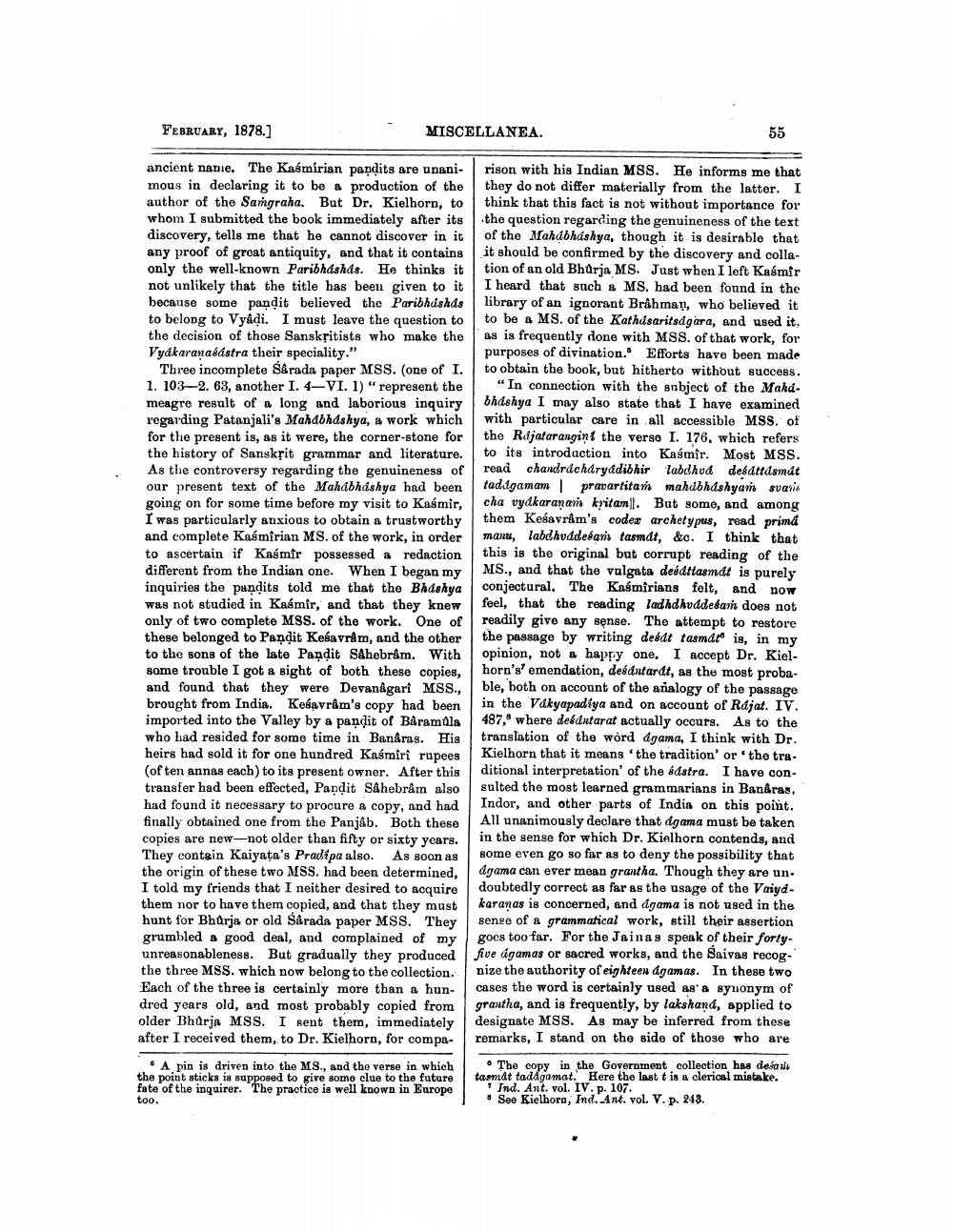________________
FEBRUARY, 1878.]
MISCELLANEA.
55
ancient nadie. The Kasmirian pandits are unanimous in declaring it to be a production of the author of the Sagraha. But Dr. Kielhorn, to whom I submitted the book immediately after its discovery, tells me that he cannot discover in it any proof of groat antiquity, and that it contains only the well-known Paribhashas. He thinks it not unlikely that the title has been given to it because some pandit believed the Paribhdshds to belong to Vyâdi. I must leave the question to the decision of those Sanskritists who make the Vyakaranasástra their speciality."
Three incomplete Sårada paper MSS. (one of I. 1. 103--2. 63, another I. 4-VI. 1)" represent the meagre result of a long and laborious inquiry regarding Patanjali's Mahabhashya, a work which for the present is, as it were, the corner-stone for the history of Sanskrit grammar and literature. As the controversy regarding the genuineness of our present text of the Mahabhashya had been going on for some time before my visit to Kaśmir, I was particularly anxious to obtain a trustworthy and complete Kasmirian MS. of the work, in order to ascertain if Kasmir possessed a redaction different from the Indian one. When I began my inquiries the pandits told me that the Bhdshya was not studied in Kasmir, and that they knew only of two complete MSS. of the work. One of these belonged to Pandit Keśavram, and the other to the sons of the late Pandit Sahebrim. With some trouble I got a sight of both these copies, and found that they were Devanagari MSS., brought from India. Kesavrâm's copy had been imported into the Valley by a pandit of Baramala who had resided for some time in Banaras. His heirs had sold it for one hundred Kasmiri rupees (of ten annas each) to its present owner. After this transfer had been effected, Pandit Sahebrâm also had found it necessary to procure a copy, and had finally obtained one from the Panjab. Both these copies are new--not older than fifty or sixty years. They contain Kaiyata's Pradipa also. As soon as the origin of these two MSS. had been determined, I told my friends that I neither desired to acquire them nor to have them copied, and that they must hunt for Bharja or old Sarada paper MSS. They grumbled a good deal, and complained of my unreasonableness. But gradually they produced the three MSS. which now belong to the collection. Each of the three is certainly more than a hundred years old, and most probably copied from older Bharja MSS. I sent them, immediately after I received them, to Dr. Kielhorn, for compa
rison with his Indian MSS. He informs me that they do not differ materially from the latter. I think that this fact is not without importance for the question regarding the genuineness of the text of the Mahdoháshya, though it is desirable that it should be confirmed by the discovery and collation of an old Bhurja MS. Just when I left Kasmir I heard that such a MS. had been found in the library of an ignorant Brahman, who believed it to be a MS. of the Kathasaritsgara, and used it. as is frequently done with MSS. of that work, for purposes of divination. Efforts have been made to obtain the book, but hitherto without success.
"In connection with the snbject of the Mahdbhdshya I may also state that I have examined with particular care in all accessible MSS. of the Rijatarangint the verso I. 176. which refers to its introduction into Kasmir. Most MSS. read chandrdchdryadibhir labdhud desdttdsmút tadigamam pravartitan mahdbhdshyar svari cha vydkaranari kritam|l. But some, and among them Keśavrâm's codes archetypus, read prima manu, labdkvddesam tasmdt, &c. I think that this is the original but corrupt reading of the MS., and that the vulgata desdttasmdt is purely conjectural, The Kasmirians felt, and now feel, that the reading ladhdhuddesain does not readily give any sense. The attempt to restore the passage by writing debdt tasmára is, in my opinion, not a happy one. I accept Dr. Kielhorn's' emendation, desdutardt, as the most probable, both on account of the analogy of the passage in the Vakyapadiya and on account of Rdjat. IV. 487, where debdntarat actually occurs. As to the translation of the word dgama, I think with Dr. Kielhorn that it means 'the tradition' or the tra. ditional interpretation of the ádstra. I have consulted the most learned grammarians in Banaras, Indor, and other parts of India on this point. All unanimously declare that dgama must be taken in the sense for which Dr. Kielhorn contends, and some even go so far as to deny the possibility that agama can ever mean grantha. Though they are un. doubtedly correct as far as the usage of the Vaiydkaranas is concerned, and dgama is not used in the senge of a grammatical work, still their assertion goes too far. For the Jainas speak of their fortyfive agamas or sacred works, and the Saivas recognize the authority of eighteen dgamas. In these two cases the word is certainly used as a synonym of grantha, and is frequently, by lakshand, applied to designate MSS. As may be inferred from these remarks, I stand on the side of those who are
SA pin is driven into the MS., and the verse in which the point sticka is supposed to give some clue to the future fate of the inquirer. The practice is well known in Europe too.
• The copy in the Government collection has dešaus taondt tadagamat. Here the last t is a clerical mistake.
Ind. Ant. vol. IV. p. 107. • See Kielhora, Ind. Ant. vol. V. p. 248.




